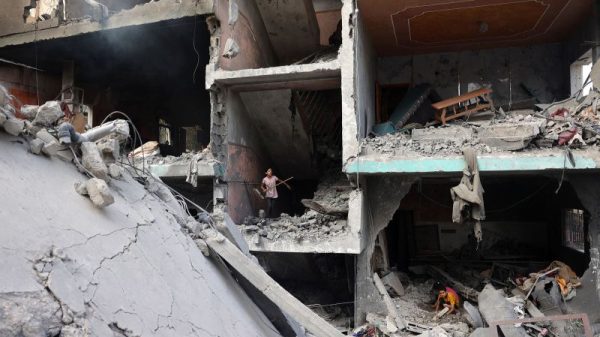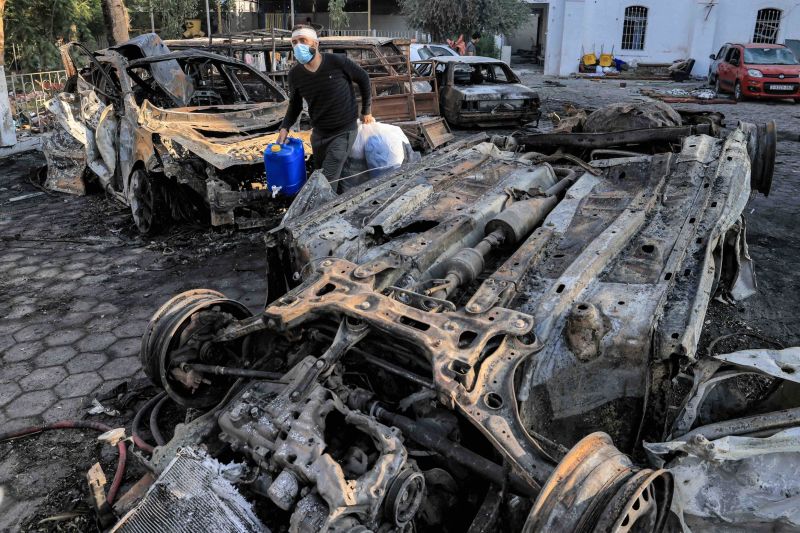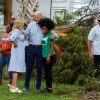In the days since a blast ripped through the packed Al-Ahli Hospital in Gaza City, killing hundreds of Palestinians, dueling claims between Palestinian militants and the Israeli government over culpability are still raging. But forensic analysis of publicly available imagery and footage has begun to offer some clues as to what caused the explosion.
Israel says that a “misfired” rocket by militant group Islamic Jihad caused the blast, a claim that US President Joe Biden said on Wednesday is backed up by US intelligence. A spokesperson for the National Security Council later said that analysis of overhead imagery, intercepts and open-source information suggested that Israel is “not responsible.”
Palestinian officials and several Arab leaders nevertheless accuse Israel of hitting the hospital amid its ongoing airstrikes in Gaza. Islamic Jihad (or PIJ) – a rival group to Hamas – has denied responsibility.
The Israel-Hamas war has triggered a wave of misleading content and false claims online. That misinformation, coupled with the polarizing nature of the conflict, has made it difficult to sort fact from fiction.
In the past few days, a number of outlets have published investigations into the Al-Ahli Hospital blast. Some have reached diametrically different conclusions, reflecting the challenges of doing such analysis remotely.
A flash of light in the dark
An Al Jazeera camera, located in western Gaza and facing east, was broadcasting live on the channel at 6:59 p.m. local time on Tuesday night, according to the timestamp. The footage appears to show a rocket fired from Gaza traveling in an upwards trajectory before reversing direction and exploding, leaving a brief, bright streak of light in the night sky above Gaza City. Just moments later, two blasts are visible on the ground, including one at Al-Ahli Baptist Hospital.
“But it’s impossible for me to confirm. If a rocket malfunctioned… it is impossible to predict its flight path and behavior, so I wouldn’t be able to draw on usual analysis drawing on altitude, flight path and the burn time,” he added.
Chad Ohlandt, a senior engineer at the Rand Corporation in Washington, DC, agreed that the bright flash of light suggested that the solid rocket motor was “malfunctioning.”
There has been some speculation on social media that the breakup of the rocket could have been caused by Israel’s Iron Dome defense system. But experts said there is no evidence of another rocket intercepting it, and Israel says that it does not use the system in Gaza.
At 7 p.m., Hamas’ military wing, the Al-Qassam Brigades, posted on its Telegram channel that it had bombarded Ashdod, a coastal Israeli city north of Gaza, with “a barrage of rockets.” A few minutes later, PIJ said on Telegram that its armed wing, Al-Quds Brigades, had launched strikes on Tel Aviv in response to the “enemy’s massacre of civilians.”
A leading US acoustic expert, who did not have permission to speak publicly from their university, analyzed the sound waveform from the video and concluded that, while there were changes in the sound frequency, indicating that the object was in motion, there was no directional information that could be gleaned from it.
Panic and carnage
Inside the hospital, the sound was deafening. Dr. Fadel Na’eem, head of the orthopedic department, said he was performing surgery when the blast sounded through the hospital. He said panic ensued as staff members ran into the operating room screaming for help and reporting multiple casualties.
After he left the operating theater, Dr. Na’eem said he found an overwhelming scene. “The medical team scrambled to tend to the wounded and dying, but the magnitude of the devastation was overwhelming.”
Dr. Na’eem said that it wasn’t the first time the hospital had been hit. On October 14, three days earlier, he said that two missiles had struck the building, and that the Israeli military had not called to warn them.
“We thought it was by mistake. And the day after [the Israelis] called the medical director of the hospital and told them, ‘We warned you yesterday, why are you still working? You have to evacuate the hospital,” Dr. Na’eem said, adding that many people and patients had fled before the blast, afraid that the hospital would be hit again.
While it is difficult to independently confirm how many people died in the blast, the bloodshed could be seen in images from the aftermath shared on social media. In photos and videos, young children covered in dust are rushed to be treated for their wounds. Other bodies are seen lifeless on the ground.
One local volunteer who did not give his name described the gruesome aftermath of the blast at Al-Ahli Baptist Hospital, saying that he arrived at 8 a.m. and helped to gather the remains of people killed there.
“We gathered six bags filled with pieces of the dead bodies – pieces,” he said. “The eldest we gathered remains for was maybe eight or nine years old. Hands, feet, fingers, I have here half a body in the bag. What were they doing, what did they do. None of them even had a toothbrush let alone a weapon.”
Analyzing the aftermath
An arms investigator said the impact was “more characteristic of a rocket strike with burn marks from leftover rocket fuel or propellant,” and not something you would see from “a typical artillery projectile.”
Cobb-Smith said that the conflagration following the blast was inconsistent with an artillery strike, but that it could not be entirely ruled out.
Others said the damage seen at the site – specifically to the burned-out cars – did not seem to suggest that the explosion was the result of an airburst fuze, which is when a shell explodes in the air before hitting the ground, or artillery fire. Patrick Senft, a research coordinator at Armament Research Services (ARES), said that he would have expected the roofs of the cars to show significant fragmentation damage and the impact site to be deeper, in that case.
“For a 152 / 155 mm artillery projectile with a point detonation fuz (one that initiates the explosion upon hitting the ground) I would expect a crater of about 1.5m deep and 5m wide. The crater here seems substantially smaller,” Senft said.
An explosives specialist, who is currently working in law enforcement and was not authorized to speak to the press, said it’s likely that the shrapnel from the projectile ignited the fuel and flammable liquid in the cars, which is why the fireball was so big. These kinds of explosions generate a shockwave that is particularly deadly to children and the frail.
The same specialist, who has spent decades conducting forensic investigations in conflict zones around the world, also said the damage at the crater site, and at the scene, was not congruent with damage normally seen at an artillery shelling site.
Without knowing what kind of projectile produced the crater, it is difficult to draw conclusions about the direction that it came from. However, the debris and ground markings point to a few possibilities.
There are dark patches on the ground fanning out in a southwesterly direction from the crater. The trees behind it are scorched and a lamppost is entirely knocked over. In contrast, the trees on the other side of the crater are still intact, even with green leaves.
Contrasting narratives
Israel has presented two contrasting narratives on which direction the alleged Hamas rocket flew in from.
Until an independent investigation is allowed on the ground and evidence collected from the site the prospect of determining who was behind the blast is remote.
Marc Garlasco, the former defense intelligence analyst and UN war crimes investigator, says there are signs of a lack of evidence at the Al-Ahli Hospital site.
“When I investigate a site of a potential war crime the first thing I do is locate and identify parts of the weapon. The weapon tells you who did it and how. I’ve never seen such a lack of physical evidence for a weapon at a site. Ever. There’s always a piece of a bomb after the fact. In 20 years of investigating war crimes this is the first time I haven’t seen any weapon remnants. And I’ve worked three wars in Gaza.”
“The local authorities did not give me free access to the area or were very unhappy that I was trying to investigate something that had clearly gone wrong from their point of view.”







































